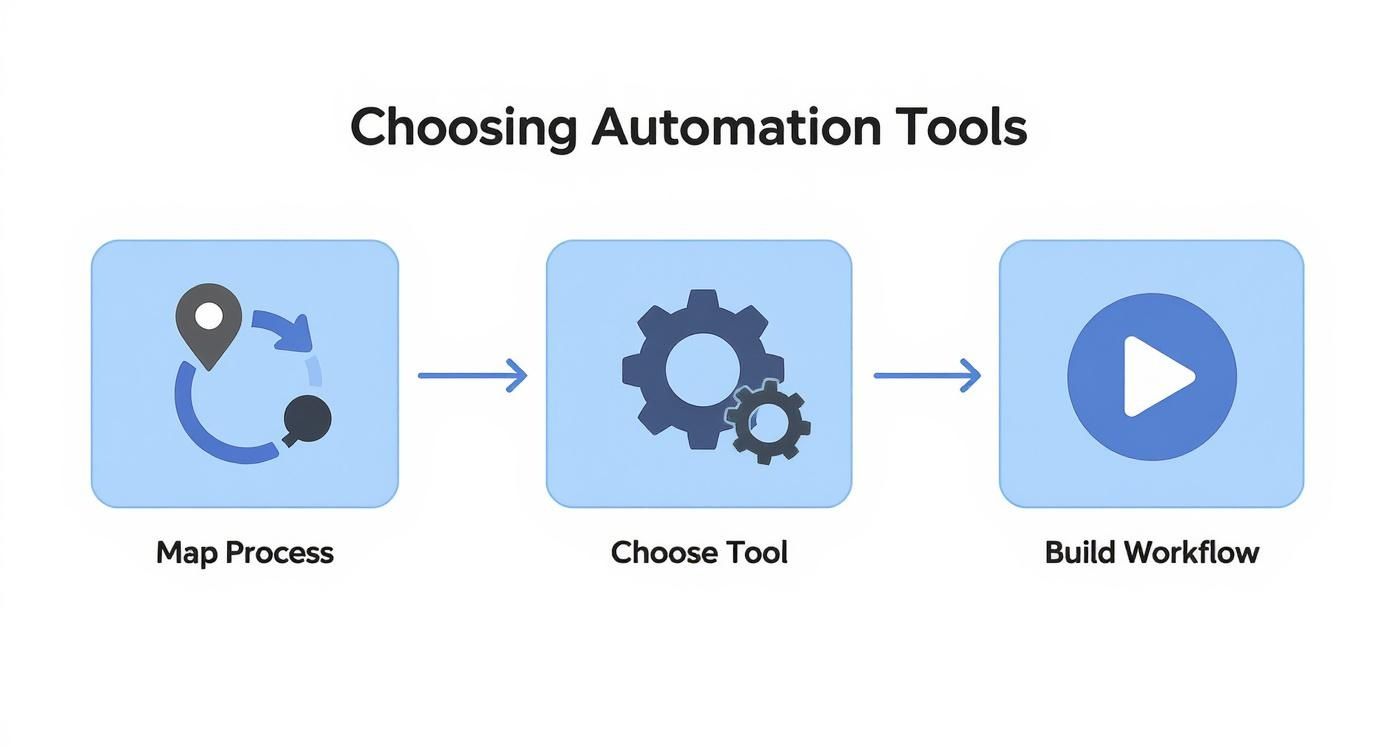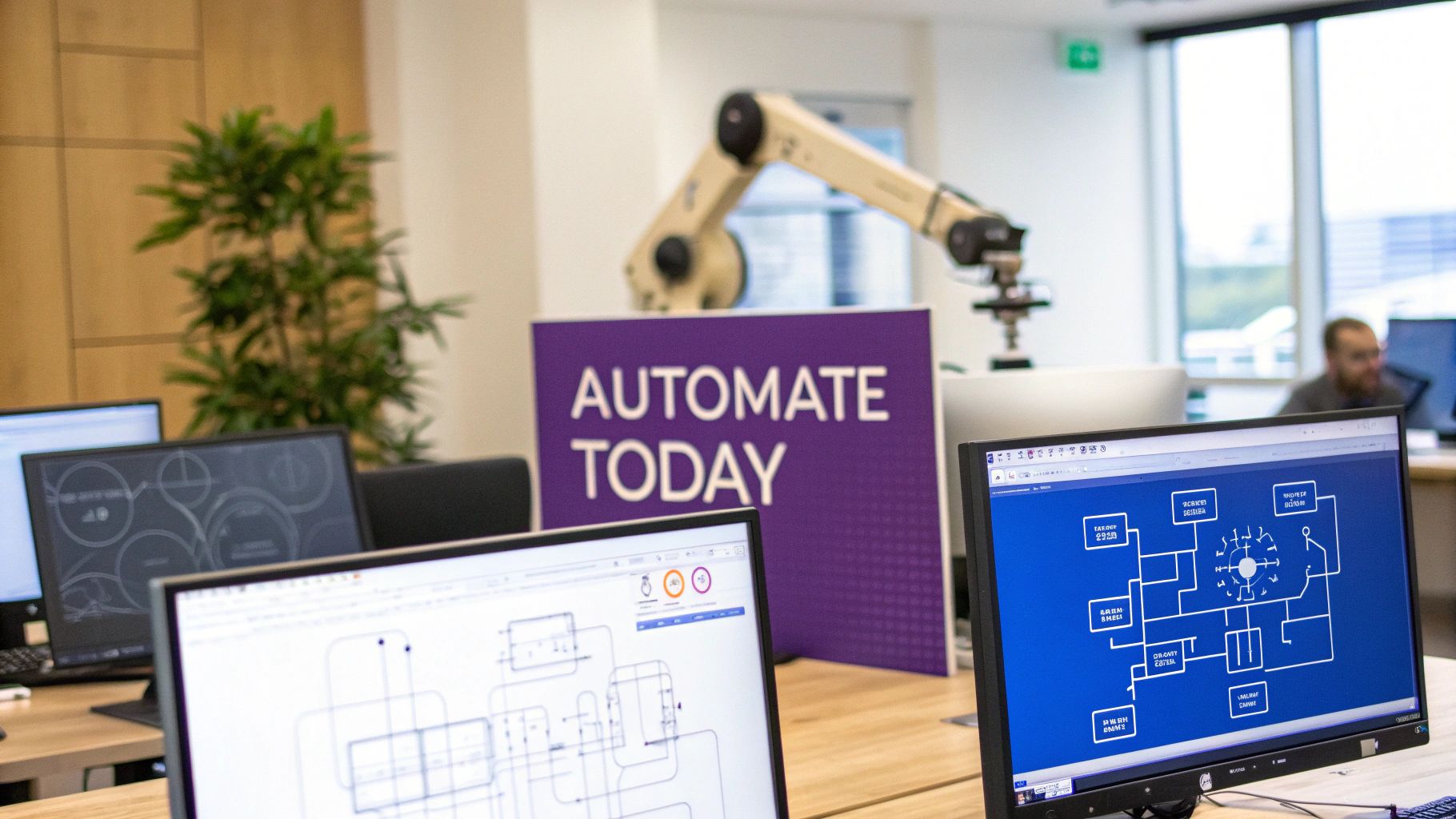How to automate business processes: A practical guide
Master how to automate business processes: identify opportunities, select tools, and implement efficient workflows that deliver real results.

Learning how to automate business processes is a practical exercise. It is a strategic move to reduce repetitive work, minimize human error, and free up your team for the kind of thinking that actually drives growth.
This guide will walk you through the practical steps to make automation a core, competitive part of your operations.
Why Business Automation Is a Competitive Necessity
In a world where speed and efficiency define the market leaders, manual processes are a serious drag on performance. Shipments get delayed, invoices linger in approval queues, and your team loses hours to soul-crushing data entry.
These are not minor inconveniences. They are real operational bottlenecks that slow your entire organization down and hit the bottom line. Business automation tackles these challenges head-on, using technology to handle the repetitive tasks that bog everyone down.
The real goal is to build smarter, more resilient operations.

The Driving Forces Behind Automation Adoption
A few key pressures are pushing businesses of all sizes to automation. The massive shift to remote and hybrid work created an urgent need for digital workflows that don't depend on someone being physically present.
At the same time, customer expectations have skyrocketed. People now demand instant responses and seamless service, something manual systems just can't deliver consistently.
This growing demand is easy to spot in market trends. The global business process automation market is projected to hit $16.46 billion in 2025, a huge jump fueled by widespread adoption. In fact, 66% of businesses have already automated at least one process, with that number expected to climb to 85% by 2029.
This growth is more than a statistic; it shows that companies are actively looking for ways to become more agile and responsive. You can explore more about future automation trends and how they're impacting businesses today.
Automation is not just a tool for large corporations anymore. With accessible AI and no-code platforms, even small teams can implement powerful workflows that were once out of reach, completely leveling the playing field.
Moving Beyond Simple Cost-Cutting
While saving money is a clear win, the true value of automation is in its power to fundamentally transform how work gets done. By taking over the rule-based, predictable tasks, automation allows your team to redirect their energy to more strategic activities.
Here’s what that looks like in the real world:
- Reduced Human Error: Automated systems follow rules perfectly, every single time. This eliminates costly mistakes in areas like data entry, invoicing, and compliance checks.
- Increased Operational Speed: Processes that once took days, like onboarding a new employee or getting a marketing campaign approved, can now be wrapped up in hours or even minutes.
- Freed-Up Creative Capacity: When your team isn't buried in administrative work, they have more headspace for innovation, customer engagement, and big-picture planning.
Ultimately, failing to automate means falling behind. Competitors who use it can operate faster, make fewer mistakes, and deliver a far better customer experience. The rest of this guide will give you a clear picture of how to make automation a critical part of staying competitive.
Finding Your First Automation Opportunity

Starting your automation journey can feel like a huge deal. The trick is to start small with a process that gives you a clear, visible win.
So many teams make the mistake of trying to automate a massive, complicated workflow right out of the gate, and it almost always leads to frustration. Instead, look for the low-hanging fruit, those tasks that are quietly draining your team's time and energy every single day.
Your first target should be a process that’s repetitive, follows clear rules, and eats up a surprising amount of time. Think about the daily or weekly routines that nobody enjoys but everyone has to do. These simple but tedious tasks are perfect candidates.
Spotting the Right Tasks to Automate
To find the best starting point, you need to know what to look for. Certain workflows have tell-tale signs that they’re ripe for automation and likely to give you a solid return on your effort. A good first project builds momentum and shows your team the real-world value of what you're doing.
Here are the key traits to look for:
- High Volume and Repetitive: The task happens a lot, daily, weekly, you name it, and follows the exact same steps each time. Think about creating weekly reports, processing standard expense claims, or sending templated follow-up emails.
- Rule-Based Logic: The process is driven by clear "if-then" logic. For instance, if an invoice is under $500 and from an approved vendor, then it gets paid automatically. If not, it's flagged for a human to review.
- Manual Data Transfer: The workflow involves someone copying and pasting data from one system to another. This could be moving customer info from an email into your CRM or shifting sales figures from a spreadsheet to a reporting dashboard.
- Prone to Human Error: Tasks that require meticulous attention to detail, like data entry, are often where small mistakes creep in. Automation eliminates these slip-ups entirely.
Finding a process that checks these boxes gives you a strong foundation. For more ideas, you can explore a variety of business process automation examples to see what other companies are successfully tackling.
The Power of Process Mapping
Once you’ve identified a potential candidate, the next step is absolutely necessary: you have to map it out. Process mapping is just a fancy way of saying you’re creating a visual blueprint of the workflow from start to finish. This is about gaining a shared view of how work actually gets done, not just drawing boxes and arrows.
Don't skip this. A common mistake is trying to automate a process you don't fully understand. Mapping reveals hidden steps, unexpected bottlenecks, and dependencies that could completely break your automation if you overlook them.
Start by documenting every single action involved. Get the people who actually do the task to walk you through it. What’s the very first trigger? What decisions do they make along the way? What tools or systems do they touch at each stage?
Your process map should capture three key elements:
- Actions: Every individual task performed, from opening an email to updating a record in a database.
- Stakeholders: Everyone who touches the process, including who starts it, who performs the work, and who gives the final sign-off.
- Systems: All the software, spreadsheets, and platforms used to get the job done.
This map becomes your guide for building the automation. It helps you account for every variable and build a solution that solves the real problem, not just the one you assumed existed. With this blueprint in hand, you're ready to pick the right tools and start building.
Selecting the Right Automation Tools for the Job
With a clear map of your process in hand, you can start exploring the tools to bring it to life. The market is flooded with options, and honestly, there's no single "best" choice for every business. Your goal is to find the software that fits the specific job you need done, not the other way around.
Thinking about how to automate means looking at the different kinds of tools out there. Some are built for simple, repetitive actions, while others use AI to manage more complex workflows with multiple decision points.
The right tool really boils down to your process, your team's technical comfort level, and your budget. Choosing the wrong one can lead to a stalled project and a lot of frustration, so it's worth taking the time to see what's available first.
Comparing Automation Approaches
The two most common categories you'll run into are Robotic Process Automation (RPA) and more intelligent, AI-driven platforms. They solve very different types of problems.
RPA is fantastic for straightforward, screen-based tasks. Think of it as a digital assistant that can mimic human actions like clicking, copying, and pasting data between applications that don't have an API. It’s perfect for legacy systems or highly structured, rule-based workflows.
AI-driven platforms are built to handle ambiguity. They can read unstructured documents like invoices, understand the context of a customer email, and even make judgments. If your process involves variables or requires a bit of "thinking," an AI-powered tool is almost always the better fit.
The key is to match the tool to the task. Using a powerful AI platform for simple data entry is overkill, but trying to make a basic RPA bot handle complex customer service inquiries will only lead to failure.
Key Features to Look For
Beyond the basic type of automation, a couple of features are becoming standard because they solve common integration and optimization challenges. Two of the most important are data mapping and process mining.
Data mapping is a feature that helps connect different applications. It allows the automation tool to know that the "customer name" field in your CRM is the same as the "client name" field in your accounting software. This is important for building workflows that span multiple systems.
Process mining digs into your system logs to create a real-time map of how your workflows are actually performing. It shows you where the real bottlenecks and inefficiencies are, often revealing opportunities for automation you might have missed.
According to a detailed analysis of leading vendors, around 70% now offer data mapping features, and about two-thirds provide process mining tools. This shows a clear industry shift to more data-driven optimization.
Automation Tool Comparison
To help you decide, we've put together a quick comparison of the main automation approaches. This should give you a clearer picture of which tool type is the best fit for your business needs.
Each of these tool types has its place, and the best choice depends entirely on the problem you're trying to solve. For a deeper look into the software available, check out our guide on business process automation tools, which covers specific platforms and their strengths.
How to Evaluate Your Options
Once you have a better sense of the types of tools, you can start evaluating specific vendors. Create a shortlist and start assessing them against what you actually need.
Here are a few practical questions to guide your decision:
- Does it integrate with our existing software? An automation tool is useless if it can't connect to the applications your team already uses every day. Check for pre-built connectors for your CRM, ERP, and other core systems.
- Is it easy for our team to use? A platform with a steep learning curve can slow down adoption. Look for tools with intuitive interfaces, especially if you want non-technical staff to build their own automations.
- Can it scale with our business? The tool you pick today should be able to handle more complex processes and a higher volume of work as your company grows.
- What does the support look like? When you run into an issue, you'll want reliable support. Check vendor reviews and see what kind of training and documentation they offer.
Beyond choosing the software, some businesses opt for professional services for automated processes to have everything implemented efficiently and effectively. This can be a smart move if your team lacks the time or expertise to manage the project internally.
Ultimately, the right solution is one that not only automates a process but also fits comfortably within your team's existing workflow and capabilities.
Building and Launching Your First Workflow
This is where your careful planning turns into a real, working automation. You've got your process map and you've picked your tool, so you're ready to build. The goal here isn't to create something perfect on day one. It's about building a solid foundation you can test, tweak, and launch with confidence.
Let's walk through this using a classic first project: automating invoice processing. This is a fantastic starting point because it's repetitive, follows clear rules, and delivers a quick win by speeding up payments and cutting down on manual errors.
Setting Up Your Workflow's Building Blocks
Every automated workflow, no matter how complex, is made of a few simple components: triggers, actions, and logic. Think of them as the "start," "do," and "decide" functions of your process.
- Triggers: This is the event that kicks everything off. For our invoice example, the trigger would be a new email arriving in the
invoices@company.cominbox with an attachment. - Actions: These are the specific tasks the automation carries out. This could be anything from downloading the email attachment to extracting the invoice number and amount, and then creating a new record in your accounting software.
- Logic (or Conditions): This is where the workflow gets smart. You can set rules that guide its path. For instance, you could add a condition: If the invoice total is less than $1,000, send it directly to the payment queue. If it's over $1,000, route it to a manager for approval.
This simple structure is incredibly powerful. It lets you translate your process map into a functional automation, and most modern tools provide a visual, drag-and-drop interface so you don't even need to write code.
The diagram below gives you a high-level look at how these pieces fit together, mapping the process, picking a tool, and then building the workflow itself.

As you can see, the actual building comes at the end, after you’ve done the necessary prep work.
The Critical Role of Thorough Testing
Once you've built your workflow, the temptation to just flip the switch is huge. Don't do it. A workflow that looks perfect on paper can easily fall apart when it meets real-world data. Thorough testing is the single most important step for a smooth and successful launch.
Your mission here is to think of all the weird scenarios your automation might run into. Don't just test the "happy path" with perfectly formatted data. You need to actively try to break it.
A workflow is only as good as its ability to handle exceptions. Testing isn't just about confirming it works; it's about discovering all the ways it can fail so you can build in safeguards before it goes live.
For our invoice example, a solid testing phase should include a mix of inputs:
- Standard Invoices: A handful of clean, perfectly formatted invoices to make sure the core logic is sound.
- Different File Types: What happens when someone sends a JPEG instead of a PDF? Does your workflow crash, or does it handle the exception gracefully?
- Missing Information: Test an invoice that's missing a PO number or a due date. Your automation should be smart enough to flag these for manual review.
- Multi-Page Documents: Can the tool correctly pull data from the second or third page of a PDF?
- Unusual Formatting: Invoices from brand-new vendors with layouts the system has never encountered before.
Testing with this kind of variety helps you find the edge cases and build in smart error handling. For example, you can add a step that automatically emails the sender asking them to resubmit their invoice as a PDF if it receives an unsupported file type. Many of these principles apply to any project where you need to automate data entry from different sources.
Choosing Your Rollout Strategy
After rigorous testing and a few tweaks, you’re ready to go live. But instead of a company-wide launch, a phased rollout is almost always the smarter, safer approach. It minimizes risk and lets you collect real-world feedback in a controlled environment.
Here are two effective strategies for rolling out your automation:
- Pilot Group Launch: Start small with a select group of users. For the invoice process, this could be the accounts payable team for just one department. This group becomes your real-world testing ground, providing invaluable feedback to help you iron out any final kinks.
- Parallel Run: For a set period, run the new automated process next to the old manual one. This lets you directly compare the results and confirm the automation is 100% accurate. It’s a bit more work upfront, but it’s the ultimate safety net, proving the new system is reliable before you retire the old way of doing things.
Once your pilot group is happy and the results check out, you can schedule the full launch. Just make sure to communicate the change clearly to everyone involved, explaining the benefits and providing any necessary training. This careful approach to building, testing, and launching sets your first automation up for success and builds momentum for all the projects that will follow.
Measuring Your Automation ROI and Scaling Up
Getting your first automation live is a huge win, but the real work starts now. A successful workflow is not a "set it and forget it" project. It needs attention to prove it’s actually delivering value. This is where you pivot from building the process to measuring its impact and planning what’s next.
Without clear metrics, your automation is just a cool tech project. With them, it becomes a powerful business case for doing more. The goal here is to prove that the time, effort, and money you invested are paying off in real, tangible ways. That proof is what gets you the buy-in to take on bigger, more impactful projects down the road.
Defining Your Key Performance Indicators
Before you can measure success, you have to define what success actually looks like. Your Key Performance Indicators (KPIs) should connect directly to the problems you wanted to solve in the first place. Were you trying to save time? Cut down on errors? Reduce costs? Your metrics need to reflect those goals.
Here are a few of the most common, and most impactful, metrics to track:
- Time Savings: This is often the easiest and most compelling metric. Figure out how long the process took by hand versus how long it takes with automation. Multiply the time saved per task by how many times the task runs each month to get your total hours saved.
- Error Rate Reduction: Manual work, especially data entry, is a magnet for mistakes. Track the number of errors (like incorrect invoice data or misrouted support tickets) before and after you automated the process. A lower error rate means higher quality work and less time wasted on fixing things.
- Cost Savings: This can be a direct result of time savings, think employee hours redirected to more valuable work. Or it might be a reduction in operational costs, like avoiding late payment fees. Calculating this helps build a rock-solid financial case for your project.
- Process Cycle Time: How long does it take for a task to get done from start to finish? Automation can slash cycle times for things like customer onboarding or purchase order approvals, which leads to a better experience for everyone involved.
Tracking these KPIs is what moves the conversation from "I think this is working" to "This automation has saved us 40 hours per month and cut invoice processing errors by 95%."
Calculating Your Return on Investment
With your metrics handy, you can calculate a clear Return on Investment (ROI). The basic formula is pretty simple: (Gain from Investment - Cost of Investment) / Cost of Investment. A positive ROI means the benefits of your automation outweigh its costs.
Your "gain" comes directly from your KPIs, the value of the time you saved, the costs you cut, and the errors you prevented. The "cost" includes things like software licenses, the time your team spent building the workflow, and any training involved.
The cost of implementing automation can vary a lot, with organizations spending anywhere from $30,000 to $250,000 depending on the complexity and scale of the workflows. But the long-term benefits are huge, with companies reporting annual savings from $10,000 to several million dollars. You can find more business process automation statistics on Zip.com to see how different industries are benefiting.
Don't forget to factor in the qualitative benefits. Things like improved employee morale (from eliminating boring tasks) and a better customer experience are harder to quantify but are incredibly valuable outcomes of a successful automation strategy.
Gathering Feedback for Continuous Improvement
Metrics tell you what is happening, but feedback from your team tells you why. The people interacting with the automated process every day are your best source of information for making it even better. They'll spot the small annoyances and hidden opportunities that data alone might miss.
Schedule regular check-ins with the team. Ask them simple, direct questions:
- Is the automation making your job easier?
- Have you run into any weird issues or exceptions?
- Are there any steps that still feel clunky or slow?
- Do you have ideas for how we could improve it?
This feedback loop is important for refinement. It turns your automation from a static solution into a dynamic one that evolves and improves over time, making sure it continues to meet the team's needs.
Scaling Your Automation Efforts
Your first successful automation is a blueprint for the future. It’s proof that this approach works in your organization, and it builds the momentum you need to tackle more complex challenges. Now is the time to think bigger and scale your efforts strategically.
Start by looking for similar processes in other departments. If you successfully automated invoice processing in finance, could the same principles be applied to purchase order approvals in operations? Your initial win provides a template you can replicate.
As you expand, consider creating a dedicated team or a "center of excellence" to lead automation initiatives across the company. This group can standardize tools, share best practices, and build a pipeline of future automation projects. This structured approach helps transform automation from a series of one-off projects into a core part of your company's operational strategy, driving efficiency and growth across the board.
Common Questions About Business Process Automation
As you start exploring how to automate different parts of your business, you're going to have questions. It’s a field with a lot of moving parts, and getting clear answers is what helps you move forward with confidence.
Here are a few of the most common questions teams run into when they first get started.
Which Business Processes Should I Automate First?
My advice is always the same: start with the tasks that are high-volume, repetitive, and driven by clear rules. These are your "quick wins."
Think about processes like accounts payable, routing new employee paperwork, or generating the same weekly reports over and over. Automating one of these simple, visible processes builds immediate momentum. It lets your team see the benefits firsthand and gets everyone comfortable with the new tech before you dive into anything more complex.
How Do I Get My Team on Board with Automation?
This all comes down to open communication. A lot of people hear "automation" and immediately worry about their jobs, so you have to address that head-on. Frame it as a tool that gets rid of the tedious, mind-numbing work, freeing them up for the more interesting, strategic stuff that actually requires a human brain.
The best way to do this is to involve them directly. Ask for their input when you’re mapping out workflows and deciding what to automate. Once people see how automation can remove the most frustrating parts of their day, they're far more likely to get on board.
Highlighting the direct, positive impact on an individual's workday is the most effective way to gain support. It shifts the conversation from a top-down mandate to a collaborative effort to improve how work gets done.
What Is the Difference Between RPA and AI Automation?
This is a classic point of confusion, but it's simpler than it sounds.
Think of Robotic Process Automation (RPA) as a tool that's great at mimicking simple, repetitive human actions on a computer. It follows a very strict, pre-defined script, like copying data from a spreadsheet and pasting it into another system. It does exactly what you tell it to, no more, no less.
AI-powered automation is a whole different beast. It’s much smarter. It can work with unstructured or messy data, like reading invoices in different formats or understanding the sentiment in a customer email. AI can make judgments based on context and even learn from past results to get better over time.
For example, an RPA bot can only move invoice data from point A to point B. An AI tool could read the invoice, check if it meets certain criteria (like being under a specific dollar amount), and then decide to approve it for payment, all without a person needing to step in.
If you're just getting started, this complete beginner's guide to AI workflow automation is a great resource for building a foundational understanding.
Ultimately, choosing between them just depends on the task. If it's a simple, predictable data transfer, RPA might be all you need. But if the process requires any kind of interpretation or decision-making, you’ll want to look at AI.
Ready to build intelligent workflows that handle complex tasks for you? With Chatiant, you can create custom AI agents and chatbots that integrate directly with your existing tools, automating everything from customer data lookups to helpdesk support. See how it works at https://www.chatiant.com.


